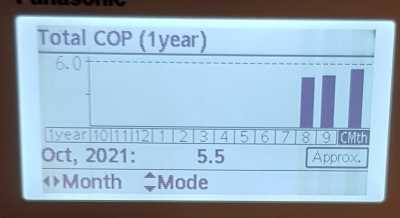Fine tuning your ASHP performance
So you have had your ASHP installed and the installer has spent 2 minutes running you through the controls, which you promptly forget as soon as they leave the property.
A quick YouTube search refreshes your memory and you realise there are so many options for controlling your system. Internal thermostats, weather compensation curves, flow temps. But which one is the most efficient for your setup and how can you find that out.
I did start logging weekly performance data from the MMSP (Metering and Monitoring Service Package), changing room temperatures one week, flow temperatures the next but quickly realised that a simple comparison between weeks wasn't enough as outside temperatures were not the same.
I did have a quick look at compensation curves but was left unclear as to whether this was relevant to UK usage.
I currently only have 8 months of data. My MCS certificate stated a SCOP of 3.52. Not sure if that was the min, mean or max performance I should expect but it's currently bubbling around between 2.7 and 3.0. (October average outside temp is 13ºC, internal set to 22º with a flow temp of 50º)
So that is the subject of this topic. How can you systematically discover the optimal setup for your system?
Any suggestions welcome, and thanks.
Posted by: @markcSo you have had your ASHP installed and the installer has spent 2 minutes running you through the controls, which you promptly forget as soon as they leave the property.
A quick YouTube search refreshes your memory and you realise there are so many options for controlling your system. Internal thermostats, weather compensation curves, flow temps. But which one is the most efficient for your setup and how can you find that out.
I did start logging weekly performance data from the MMSP (Metering and Monitoring Service Package), changing room temperatures one week, flow temperatures the next but quickly realised that a simple comparison between weeks wasn't enough as outside temperatures were not the same.
I did have a quick look at compensation curves but was left unclear as to whether this was relevant to UK usage.
I currently only have 8 months of data. My MCS certificate stated a SCOP of 3.52. Not sure if that was the min, mean or max performance I should expect but it's currently bubbling around between 2.7 and 3.0. (October average outside temp is 13ºC, internal set to 22º with a flow temp of 50º)
So that is the subject of this topic. How can you systematically discover the optimal setup for your system?
Any suggestions welcome, and thanks.
If you find out,let me know!.
From my limited knowledge, weather compensation is a good thing. When it 13 degrees outside, my flow temps are high 30s (radiators) and it warms the house nicely. That's got to be better than 50 for a heat pump. I have only just got MMSP installed and it's not quite all working yet. Can you see the detailed data logs from yours? It's quite interesting to see how the energy consumption varies over time when the system starts up, etc.
I thought the MCS COP was the manufacturers standard rating (at a set flow temp, air temp, lab conditions), a bit like the mpg figures you see for cars. My real COP is similar to yours, maybe slightly higher.
Which heat pump/MMSP do you have?
Posted by: @kev-mPosted by: @markcSo you have had your ASHP installed and the installer has spent 2 minutes running you through the controls, which you promptly forget as soon as they leave the property.
A quick YouTube search refreshes your memory and you realise there are so many options for controlling your system. Internal thermostats, weather compensation curves, flow temps. But which one is the most efficient for your setup and how can you find that out.
I did start logging weekly performance data from the MMSP (Metering and Monitoring Service Package), changing room temperatures one week, flow temperatures the next but quickly realised that a simple comparison between weeks wasn't enough as outside temperatures were not the same.
I did have a quick look at compensation curves but was left unclear as to whether this was relevant to UK usage.
I currently only have 8 months of data. My MCS certificate stated a SCOP of 3.52. Not sure if that was the min, mean or max performance I should expect but it's currently bubbling around between 2.7 and 3.0. (October average outside temp is 13ºC, internal set to 22º with a flow temp of 50º)
So that is the subject of this topic. How can you systematically discover the optimal setup for your system?
Any suggestions welcome, and thanks.
If you find out,let me know!.
From my limited knowledge, weather compensation is a good thing. When it 13 degrees outside, my flow temps are high 30s (radiators) and it warms the house nicely. That's got to be better than 50 for a heat pump. I have only just got MMSP installed and it's not quite all working yet. Can you see the detailed data logs from yours? It's quite interesting to see how the energy consumption varies over time when the system starts up, etc.
I thought the MCS COP was the manufacturers standard rating (at a set flow temp, air temp, lab conditions), a bit like the mpg figures you see for cars. My real COP is similar to yours, maybe slightly higher.
Which heat pump/MMSP do you have?
Mitsubishi Ecodan 14Kw R32 with the MelCloud MMSP. I had 4 months of incorrect metering as they had been wired up incorrectly, registering energy output only, not consumption. So my first 4 months show a SCOP of 6500 🙂
Posted by: @markcPosted by: @kev-mPosted by: @markcSo you have had your ASHP installed and the installer has spent 2 minutes running you through the controls, which you promptly forget as soon as they leave the property.
A quick YouTube search refreshes your memory and you realise there are so many options for controlling your system. Internal thermostats, weather compensation curves, flow temps. But which one is the most efficient for your setup and how can you find that out.
I did start logging weekly performance data from the MMSP (Metering and Monitoring Service Package), changing room temperatures one week, flow temperatures the next but quickly realised that a simple comparison between weeks wasn't enough as outside temperatures were not the same.
I did have a quick look at compensation curves but was left unclear as to whether this was relevant to UK usage.
I currently only have 8 months of data. My MCS certificate stated a SCOP of 3.52. Not sure if that was the min, mean or max performance I should expect but it's currently bubbling around between 2.7 and 3.0. (October average outside temp is 13ºC, internal set to 22º with a flow temp of 50º)
So that is the subject of this topic. How can you systematically discover the optimal setup for your system?
Any suggestions welcome, and thanks.
If you find out,let me know!.
From my limited knowledge, weather compensation is a good thing. When it 13 degrees outside, my flow temps are high 30s (radiators) and it warms the house nicely. That's got to be better than 50 for a heat pump. I have only just got MMSP installed and it's not quite all working yet. Can you see the detailed data logs from yours? It's quite interesting to see how the energy consumption varies over time when the system starts up, etc.
I thought the MCS COP was the manufacturers standard rating (at a set flow temp, air temp, lab conditions), a bit like the mpg figures you see for cars. My real COP is similar to yours, maybe slightly higher.
Which heat pump/MMSP do you have?
Mitsubishi Ecodan 14Kw R32 with the MelCloud MMSP. I had 4 months of incorrect metering as they had been wired up incorrectly, registering energy output only, not consumption. So my first 4 months show a SCOP of 6500 🙂
That's interesting; same ASHP and MMSP but mine isn't registering energy output, only consumption. I'm trying to get the supplier back to fix it. Does yours monitor energy consumed from the ASHP and the Immersion/ancillaries separately? Mine doesn't and I think it should.
Posted by: @kev-mPosted by: @markcPosted by: @kev-mPosted by: @markcSo you have had your ASHP installed and the installer has spent 2 minutes running you through the controls, which you promptly forget as soon as they leave the property.
A quick YouTube search refreshes your memory and you realise there are so many options for controlling your system. Internal thermostats, weather compensation curves, flow temps. But which one is the most efficient for your setup and how can you find that out.
I did start logging weekly performance data from the MMSP (Metering and Monitoring Service Package), changing room temperatures one week, flow temperatures the next but quickly realised that a simple comparison between weeks wasn't enough as outside temperatures were not the same.
I did have a quick look at compensation curves but was left unclear as to whether this was relevant to UK usage.
I currently only have 8 months of data. My MCS certificate stated a SCOP of 3.52. Not sure if that was the min, mean or max performance I should expect but it's currently bubbling around between 2.7 and 3.0. (October average outside temp is 13ºC, internal set to 22º with a flow temp of 50º)
So that is the subject of this topic. How can you systematically discover the optimal setup for your system?
Any suggestions welcome, and thanks.
If you find out,let me know!.
From my limited knowledge, weather compensation is a good thing. When it 13 degrees outside, my flow temps are high 30s (radiators) and it warms the house nicely. That's got to be better than 50 for a heat pump. I have only just got MMSP installed and it's not quite all working yet. Can you see the detailed data logs from yours? It's quite interesting to see how the energy consumption varies over time when the system starts up, etc.
I thought the MCS COP was the manufacturers standard rating (at a set flow temp, air temp, lab conditions), a bit like the mpg figures you see for cars. My real COP is similar to yours, maybe slightly higher.
Which heat pump/MMSP do you have?
Mitsubishi Ecodan 14Kw R32 with the MelCloud MMSP. I had 4 months of incorrect metering as they had been wired up incorrectly, registering energy output only, not consumption. So my first 4 months show a SCOP of 6500 🙂
That's interesting; same ASHP and MMSP but mine isn't registering energy output, only consumption. I'm trying to get the supplier back to fix it. Does yours monitor energy consumed from the ASHP and the Immersion/ancillaries separately? Mine doesn't and I think it should.
It will be a simple wire in the wrong place but you need someone who knows what they are doing to fix it. No, it just measures DHW and Heating as two inputs/outputs.
We have the DHW set to be on 24/7 and maintain 50º with a 5º drop to trigger a reheat. From my understanding the only time the immersion would be used is if you drain the tank and need more hot water quickly, so manually turn the DHW heating on or when the legionella cycle runs.
I have a 250l tank and have never totally drained it of hot water.
Posted by: @markcSo you have had your ASHP installed and the installer has spent 2 minutes running you through the controls, which you promptly forget as soon as they leave the property.
A quick YouTube search refreshes your memory and you realise there are so many options for controlling your system. Internal thermostats, weather compensation curves, flow temps. But which one is the most efficient for your setup and how can you find that out.
I did start logging weekly performance data from the MMSP (Metering and Monitoring Service Package), changing room temperatures one week, flow temperatures the next but quickly realised that a simple comparison between weeks wasn't enough as outside temperatures were not the same.
I did have a quick look at compensation curves but was left unclear as to whether this was relevant to UK usage.
I currently only have 8 months of data. My MCS certificate stated a SCOP of 3.52. Not sure if that was the min, mean or max performance I should expect but it's currently bubbling around between 2.7 and 3.0. (October average outside temp is 13ºC, internal set to 22º with a flow temp of 50º)
So that is the subject of this topic. How can you systematically discover the optimal setup for your system?
Any suggestions welcome, and thanks.
Markc, I am sorry to say but with a flow temperature of 50 deg C at this time of year, I hope you have a very big pocket because your bill is going to be very high. It appears that your system has been very poorly designed and set up and certinly, with a predicted SCOP of 3.52, not designed for performance but for low installation cost. The flow temperature should be in the high 20's at this time of year.
SCOP is the anual average performance or total heat produced by the machine divided by the electricity used. At this time of year you should be runnig at above 5. Here is a picture from one of my installations.
@heacol, I had no idea the flow temperature should be so low (20C) in November. We're currently running at 35C (manually set) at it feels about right - COP at just over 3 for later September to today.
Get a copy of The Ultimate Guide to Heat Pumps
Subscribe and follow our YouTube channel!
@editor Mars, your unit had a co of 3, My customers had a COP of 5. He has used nearly halve the electricity you have to do the same job, that will be the same for every month of the year. His house has no thermostats and the house is treated as a single zone with TRV's the bedroom radiators to reduce the temperatures there. The heat pimp controlls the temperature in the living areas, all living areas and batherooms are kept at the same temperatures. It is contrary to the normal thinking, but it works.
@heacol, does you customer have very good/excellent insulation?
Get a copy of The Ultimate Guide to Heat Pumps
Subscribe and follow our YouTube channel!
Posted by: @heacol@editor Low flow temperatures = low bills. It realy is that simple.
Fabric first to achieve low flow temperatures I guess. Our insulation is good to very good, but we still leak some heat. Getting better though.
Get a copy of The Ultimate Guide to Heat Pumps
Subscribe and follow our YouTube channel!
@editor No, it is a 1930's ex council house with cavity wall insulation, double galzing installed about 20 years ago and 250 mm of rockwool in the loft.
A standard off the shelf ex-councill house.
You are correct, it should always be fabrick first, however it is not always necessary or economical.
Your house is your house, some are leaky and others are passive, it is not always possable or make economical sence to make a leaky solid stone house in to a passive pouse. What does make economical sence is to replce a bad fossel fuel system with a reneawble low carbon heating system that is cheaper to run and provides a better living enviroment.
If you have to play with your system there is something wrong. Initially there should be some tweeking but after that, it should just work without any intervention. If your flow temperature is high, is is caused by one of 2 things:- firstly, there are too many levels of controwl, "too many chefs spoil the broth", this is easy to fix, just remove them and allow the heat pump to do it's job. The second is your emmitters are too small or you are not giving then mime to react. Please remember that 80% of a radiator's output is through convection, the lower the flow temperature the longer the convections takes to work (up to 4 hours).
-
Have Consumers Been Lied to About the Efficiency of Heat Pumps Made in China?
5 months ago
-
Ecodan consuming 100kwh per day in new build!!!
5 months ago
-
Help with understanding my Mitsubishi Ecodan air source heat pump
8 months ago
-
Efficiency Concerns on newly installed Mitsubishi Ecodan 8.5kW
8 months ago
-
Running my new Nibe ASHP efficiently
11 months ago
- 26 Forums
- 2,360 Topics
- 53.5 K Posts
- 206 Online
- 6,026 Members
Join Us!
Worth Watching
Latest Posts
-

When I was 18, it wasn't enough to own a car; I had to ...
By Majordennisbloodnok , 6 minutes ago
-
RE: Mitsubishi Ecodan R290 10kW performance
Interesting. Thanks for the info.That would explain th...
By Sheriff Fatman , 14 minutes ago
-
RE: My Powerwall 3 Consumes 3-4 kWh/Day in Self-Consumption: Is This Normal?
@f1p Might be normalmy numbers 3+ year old powerwall 2,...
By ksim , 3 hours ago
-
RE: New Fogstar 15.5kWh upright solution
SITREP #5 (I think) Milestone completed toda...
By GGW , 14 hours ago
-
RE: Octopus Cosy Heat Pump Owners & Discussion Thread
The FT levels off at either the set point OR the minimu...
By AndrewJ , 14 hours ago
-
RE: MyVaillant Connect Regular Disconnect
Thanks. Yes, if the time is consistently 11pm every nig...
By buckwem , 14 hours ago
-

RE: Speedcomfort radiator fans
My take on Speedcomfort radiator fans: If anyone w...
By Mars , 20 hours ago
-
RE: Midea ASHP – how to set weather compensation
@pash44pump I have yet to come across any Clivet or Mid...
By benson , 20 hours ago
-
RE: Who's your electricity provider and what's your tariff?
@transparent Thanks, this helps. Could it be that St...
By Batpred , 21 hours ago
-
RE: Clivet ASHPs and weather compensation
Simon did share a lot of very helpful advice. On furthe...
By ambris , 21 hours ago
-
RE: Home Assistant vs ESPAltherma.
@majordennisbloodnok Thanks very much.
By Ubert767 , 22 hours ago
-

RE: Setback savings - fact or fiction?
I could, but I think we can do better, by plotting hour...
By cathodeRay , 2 days ago
-
RE: Advice on internal circulation pump noise
Extend the primary branch and make sure you have more t...
By ASHP-BOBBA , 2 days ago
-

RE: External pipework insulation
Oh Dear! that's appalling pipe work, should've been in ...
By dgclimatecontrol , 2 days ago
-

RE: Jokes and fun posts about heat pumps and renewables
By Morgan , 2 days ago
-

RE: Controlling Daikin Altherma via P1P2 and Home Assistant
On the contrary, @toodles, that’s a lot of help. I’d ne...
By Majordennisbloodnok , 2 days ago
-

Parsnip, Bacon & Coconut Milk Soup
First let me say, I am only a cook because I am human a...
By Toodles , 3 days ago
-
RE: Electricity price predictions
Ben Watts posted on LinkedIn that he had updated this w...
By Judith , 3 days ago






